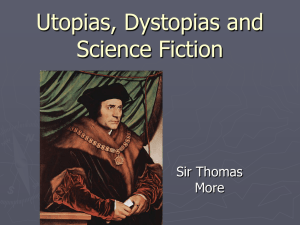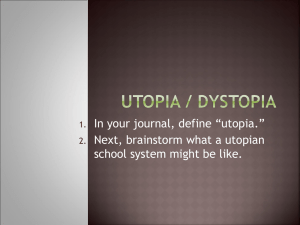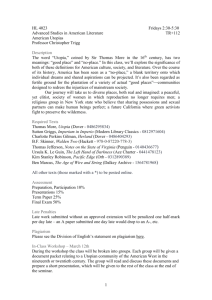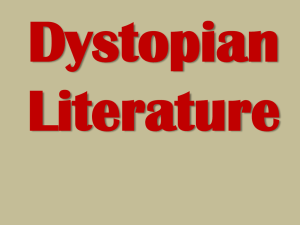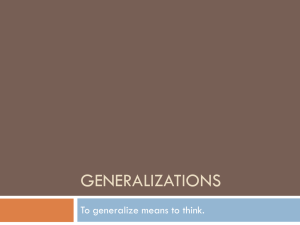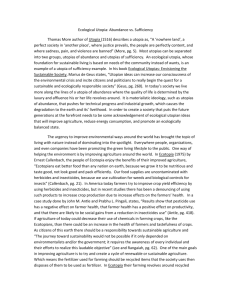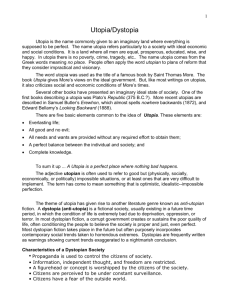BRIEF NOTES ON UTOPIA, DISTOPIA AND HISTORY
advertisement
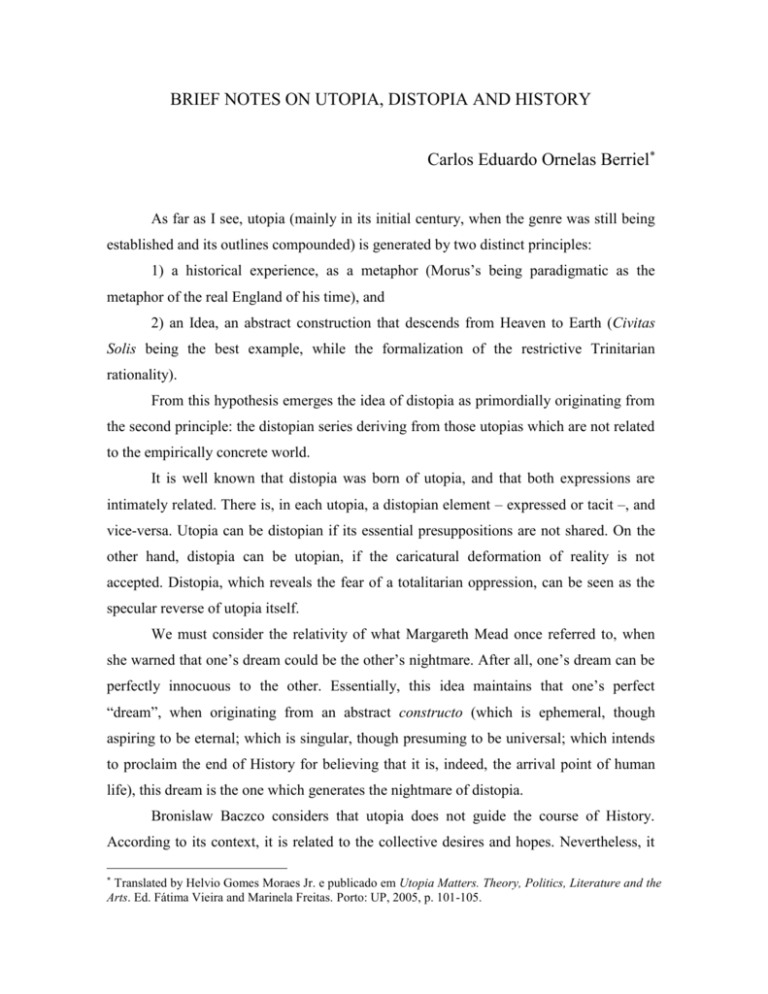
BRIEF NOTES ON UTOPIA, DISTOPIA AND HISTORY Carlos Eduardo Ornelas Berriel* As far as I see, utopia (mainly in its initial century, when the genre was still being established and its outlines compounded) is generated by two distinct principles: 1) a historical experience, as a metaphor (Morus’s being paradigmatic as the metaphor of the real England of his time), and 2) an Idea, an abstract construction that descends from Heaven to Earth (Civitas Solis being the best example, while the formalization of the restrictive Trinitarian rationality). From this hypothesis emerges the idea of distopia as primordially originating from the second principle: the distopian series deriving from those utopias which are not related to the empirically concrete world. It is well known that distopia was born of utopia, and that both expressions are intimately related. There is, in each utopia, a distopian element – expressed or tacit –, and vice-versa. Utopia can be distopian if its essential presuppositions are not shared. On the other hand, distopia can be utopian, if the caricatural deformation of reality is not accepted. Distopia, which reveals the fear of a totalitarian oppression, can be seen as the specular reverse of utopia itself. We must consider the relativity of what Margareth Mead once referred to, when she warned that one’s dream could be the other’s nightmare. After all, one’s dream can be perfectly innocuous to the other. Essentially, this idea maintains that one’s perfect “dream”, when originating from an abstract constructo (which is ephemeral, though aspiring to be eternal; which is singular, though presuming to be universal; which intends to proclaim the end of History for believing that it is, indeed, the arrival point of human life), this dream is the one which generates the nightmare of distopia. Bronislaw Baczco considers that utopia does not guide the course of History. According to its context, it is related to the collective desires and hopes. Nevertheless, it * Translated by Helvio Gomes Moraes Jr. e publicado em Utopia Matters. Theory, Politics, Literature and the Arts. Ed. Fátima Vieira and Marinela Freitas. Porto: UP, 2005, p. 101-105. does not brings with it the historical scenery for whose realization it has contributed. No utopia foresees its own future1. In other words: the utopias, by emerging from real elements, reconstruct all possible Histories, all sceneries not accomplished by History. This idea has its roots in Aristotle’s Poetics, where it is said that poetry is wider than history, once it carries out, till the end, what History only have sketched. Hegel defines a notably rich reality, wherein the existent being has many dimensions at his disposal– all of them real. Everything that arises as a real tendency, even if it is not concretely fulfilled, also acquires the statute of reality. Here is the point where utopia is philosophically legalized. It is an active and effective tendency of reality, although it’s not realized while State. It inhabits the ethical dimension. Its condition as a genre is in the items tendency of reality and non-accomplishment. The relation between the illusory and the real is extremely intimate in utopia as well as in the accounts of the voyages of discovery. The imaginary organizes the real experience, while this later serves as a base for inner elaborations: the boundaries between real and illusory are, thus, indefinite. In utopia, the ideal subordinates the real with the same commitment with which, in the voyages of discovery, it unites real and illusory: the boundaries between true and false are diluted. Very different are the perspectives by which the authors of utopias and distopias build their constructions; both, however, are ruled by the same laws, as tragedy and comedy, according to the classical Aristotelian judgement, are likewise. We may consider that: a) the classical utopia is built from a hiatus (never suppressed) between real History and the espace reserved for the utopian projections; the discovery of a distant country, until then ignored (as we may find in the plots of Morus, Campanella and others) became the symbol of a fracture, which is not only geographical, but, above all, historical; b) distopia attempts to be in continuity with the historical process, by enlarging and formalizing the negative tendencies which are active in the present and may conduct, almost inevitably, if they are not obstructed, to the perverse societies (distopia itself). “Finzione storiche e congiunture utopiche”, pg. 14, in “Nell’ anno 2000 – Dall’utopia all’ucronia”. Leo S. Olschki editore, Firenze, MMI. 1 In utopia, the cultural and politically society constituted by History is absorbed with the aim of being surpassed by the image of the established ideal City. In this sense, exemplary is the adoption, by many utopians, of the tale of an adventurous voyage in which the narrator disembarks in an unknown land. Such a presence plays a fundamental role in utopia: it constitutes that space-temporal fracture which permits the proper existence of the utopian representation; the long extension of the trip allows the narrator to leave behind him his own social, political, religious and economic experience, to live in a world whose geographical, and, consequently, historical and cultural isolation, created institutions and uses which have nothing in common with the original reality of the traveler. Thus, we are placed in front of a radically diverse society; but such a differentiation in utopia becomes specular contraposition: the negative structure of the existent human organization is subjected to that positive structure of the imagined New City. In this manner, the author attempts to surpass the contingent reality by proposing, as an alternative, a perfect society rationally founded. On the other hand, in distopia not only is reality assumed the way it is, but also its negative practices and tendencies, developed and enlarged, provide the material for the edification of the structure of a grotesque world. In short, it is proper of the historical dimension the determination of the difference between utopia and distopia: the imagined happy place is, indeed, a non-place, in the sense that it is not spatially located in its author’s own world; for what the utopian wants to “show” us is the image of a rational and happy world, and, by means of this demonstration, admonish us to feel moved to energetically imprint on History a different sense from that one, until then, predominant. As it is already known, Morus’s utopia has a real base, which is the actual England, severely studied in his text. Utopia is not the result of a delirium, but it was born of the concrete necessities of combating fighting destiny, of founding a “second nature” for man – History. This is the generous face of utopia. Not all the examples of the genre were like this one. The utopias of the Counter Reformation period, which are transfigurations of actual societies, did not originate from a society used as a reference. On the contrary, they conceived a polis and a collective life from abstract concepts, formulated by an intensely defensive Church. They are metastasis of convents and monasteries, wherein the necessary practices of extra-monkish life (work, coexistence, marriage, reproduction, political participation, etc.) are submitted to a complete set of rules which removes the civil spontaneity from these same activities, being finally rendered in clerical discipline2. Distopia, therefore, is the prolongation of the profile of those utopias which are built of abstract propositions, and not of metaphors or allegories. The absolute social control, born the Counter Reformation, led to a variant of utopias, which achieves its full expression in Civitas Solis, its best example, and the one which will provide the elements for the future distopia. This does not emerge unexpectedly, like a lightning in a blue sky, but it already breathed in the former utopias of the Counter Reformation (Agostini, Patrizi, Buonamico). The notion of social perfectibility, therefore, is not, nor could it be, born of a concrete human experience, generator of resoluble problems. Instead, it arises uncontaminated by History, as an ideal constructo, from where man’s empiric dimension is removed. The solitude that emanates from the paintings of Piero della Francesca concerning the ideal city tells us very much about this disposable humanity; those are not cities built for the actually existent man, but a complex in which architecture and urbanism leave place and substance to sculpture, and human presence unbalances and stains the whole. Its rationality becomes rough, and its capability of leading to the emancipation of the associated living is mixed with its opposite, its own denial: Like Oedipus at Colonos, the individual ends up purged from the same polis which he emancipated from the puzzling chimera. There would exist two central moments in History marked by intolerance, and which possibly provide the founding elements of distopia; they were two frail, unstable, defensive social conjunctions – in spite of the contrary appearance: the Trinitarian Catholic Church and the Soviet State. These institutions, in their affirmative process, created the illusion of being perfect for being, in fact, incapable of enduring dissension – something that could certainly destroy them. The illusion of being perfect forms, alreadyaccomplished utopias, generated, although involuntarily, the material which will be formalized in distopia. 2 This is central and constitutive in Orwell’s 1984, for instance. The Trinitarian social abstraction may have a similar element in Soviet hyperrationalism, which derived from Lenin and reached his full meaning with Stalin. Utopia, or its imagetic resource, came across a virtual obstacle in the manifestations of the vulgar Marxism. The Soviet States disallowed, and, implicitly, inhibited the utopian reflection, for considering social perfection an aim already attained by the perfect disposition of the State to reach perfectibility. The official desideratum should be enough to discourage utopian cogitations. The hyper-rationalism makes prevailing a conception judged as rational (while it is, indeed, abstract equations, engendered by political engineering) even when it presents disturbing symptoms, mainly in the form of a disintegration of individuals – that are removed from the problematic universe. Sixteenth-century blazes and modern gulags ended up forming a symmetry. When Campanella edified his perfect city as a hipostasis of monkish life, he was implicitly considering the Church as the perfection of collective life; when Twentiethcentury left considered utopia a non-subject, it was considering Soviet collectivism as the unsurpassable summit of the associated living. Distopia derived from these attitudes. The great question that constitutes the hidden face, the utopian interdict, is that perfectibility lies in the complete foresight of all human actions and desires, which are fulfilled even before they are thought. The State presumed them in advance, having accomplished them afterwards. Or forbade them3. In ampler terms, History should not be effected by man’s concrete experience. On the contrary, it should be seen as the product of an omniscient State; it should appear as a sub-product of human will, filtered by the state strainer. Where would the obstructed residue be accumulated? The answer will be distopia: it is the residue obstructed by a completely rational State. Distopia is, after all, the mirror of History’s suspension; its image is the humanity’s exile, a humanity turned into residue by a maddened reason. With the word, the post-modernity thinkers. 3 The movie Minority Report, based on Philip K. Dick’s novel, presents a society in which the crimes are foreseen by mutant creatures, and the virtual criminal is detained before the execution of the offense, being kept in metabolic suspension eternally. This movie illustrates what is ab ovo in the nature of the paradigmatic utopias.
